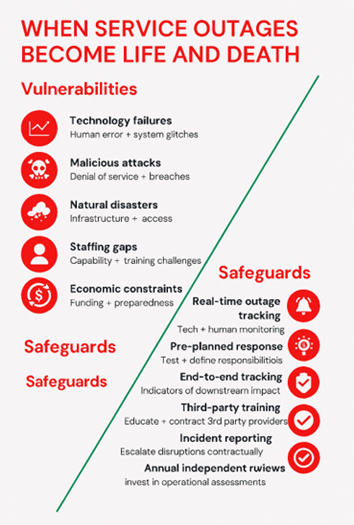By
Deepak Selvaratnam
|
Date Published: September 30, 2025 - Last Updated September 30, 2025
|
Comments
A recent outage at a telecom provider tragically resulted in the loss of three lives — and the full extent of hardship is still unfolding. This incident is not isolated. It mirrors findings from recent Snapshotz reviews conducted across three medical centers, two utility providers and two social service agencies — organizations where being unreachable isn’t just inconvenient; it can be fatal.
These clients, operating with internal teams and outsourced contact centers, face a common challenge: the hidden fragility of service continuity in life-critical environments.
The accompanying infographic outlines the key vulnerabilities — from technology failures and staffing gaps to natural disasters and cyberattacks — and the safeguards needed to prevent harm, death or material damage.
Key learnings from the reviews:

- Risks are often subtle and easily missed. While systems may exist, frontline agents are not adequately trained to identify risks that aren’t overt or obvious.
- Clarity and training are essential. Defining what constitutes a risk — and incentivizing its reporting — can dramatically improve early detection.
- Incident tracking is resource-intensive. Without proper tools and oversight, monitoring complaints and disruptions can overwhelm teams. AI and automation can help surface patterns and reduce exposure.
- AI is underutilized. Real-time incident capture — especially those affecting internal operations or posing life-threatening risks — is not being harnessed to its full potential.
Snapshotz continues to reveal these blind spots and guide organizations toward operational resilience. In sectors where lives depend on service continuity, the cost of inaction is simply too high.
Today’s service environments face a growing list of risks:
- Technology failures —whether system glitches or human error
- Malicious attacks — denial of service and system breaches
- Natural disasters —disrupting infrastructure and access
- Staffing and capability gaps
- Economic constraints impacting resilience
To ensure continuity — especially in life-critical sectors — certain safeguards must be non-negotiable:
- Real-time performance monitoring across systems and teams — including third-party and external providers — to identify and address barriers preventing customer access.
- Clearly defined and regularly tested response plans
- End-to-end outage tracking with downstream impact indicators
- Training for third-party providers to capture and report disruptions
- Contractual obligations for incident reporting and escalation
- Annual independent reviews — worth every cent